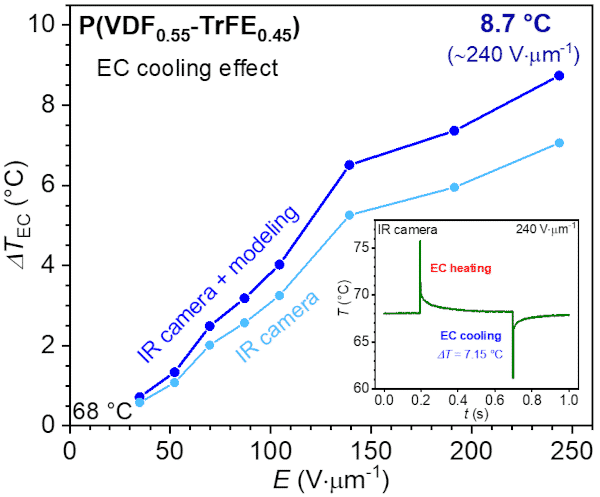
Direct measurement of electrocaloric effect in polyvinylidene fluoride-based copolymers
2Centre de Recherche Rhône-Alpes, PIEZOTECH S.A.S, ARKEMA France, Pierre-Bénite Cedex, France
Solid-state cooling using the electrocaloric (EC) effect – reversible temperature change of the material upon application of an external electric field – has emerged as one of the promising alternatives to existing conventional cooling technologies. Since the electric field is relatively easy and cheap to generate, the EC effect is of particular interest for cooling small and flexible electronic devices. Due to their large electrocaloric effect polyvinylidene fluoride (PVDF)-based polymers are promising EC active materials that can replace the currently widely used lead-based ceramics. Interestingly, the ferroelectric and thus electrocaloric properties of polyvinylidene fluoride-trifluoroethylene copolymers P(VDF-TrFE) can be tuned by varying the TrFE comonomer content. We show here that they stand for a promising active material for EC applications.
In this contribution, we focus on the preparation and functional characterization of various free-standing P(VDF1-x-TrFEx) (x = 0.30–0.55) copolymer films. By combining direct EC measurements using infrared imaging and numerical modeling, we are able to compare and identify the most suitable compositions for different selected working temperature ranges. The prepared films exhibit high dielectric breakdown strength of more than 200 V∙μm−1, resulting in large adiabatic EC temperature changes of almost 9 °C for the composition x = 0.45 (Figure 1). We believe that the systematic direct EC characterization of various PVDF-based copolymers presented here will provide a better overview of their capabilities and thus accelerate the process of their integration into functional cooling devices.

Figure 1. Directly determined EC cooling effect of P(VDF0.55-TrFE0.45) at 68 °C and (inset) corresponding EC cycle, observed with the IR camera.
Powered by Eventact EMS
